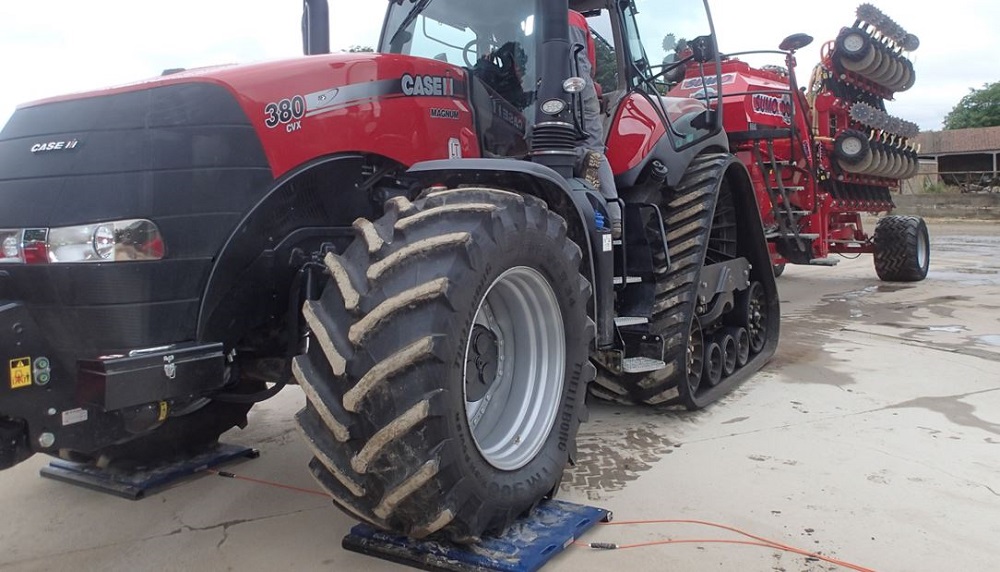- Home
- Knowledge library
- How trafficking affects cultivations and establishment for arable crops
How trafficking affects cultivations and establishment for arable crops
How to reduce the risk of compaction damage to soil structure from tractors and trailed machinery.
Overview
The combination of low ground pressures with controlled-traffic farming can reduce the need for remedial tillage and enable direct drilling, when appropriate.
Where implement or drilling width is low, ground pressure and controlled-trafficking considerations become highly important.
Typically, a four-metre drill pulled by a tractor with 710 mm-wide tyres will traffic almost 40% of the area farmed, potentially more, after headland turning has been considered.
Ground pressures
Ground pressures exerted by tractors and trailed machinery determine the severity of soil structure damage − which is largely caused by a reduction in porosity.
Appropriate choice of tyres and/or tracks can reduce damage associated with higher axle loads (equipment weight). It can also improve fuel efficiency and overall machine output.
High axle loads push compaction deeper throughout the profile, which is harder to remedy.
Ballasted weight
Correctly ballasted machines will maximise tractive efficiency and keep wheel/track slip low.
Determine the appropriate ballasted weight for each operation, including the split between front and rear axles on wheeled tractors.
Tracked vehicles must also be ballasted appropriately so the tracks are in even ground contact from the front to the rear.
Top tip: Use weigh cells to determine the maximum ballasted axle loadings for various operations. Once done, adjust tyre pressures accordingly.
Trailed/mounted equipment
Trailed equipment allows the tractor to be optimally ballasted to pull the implement.
Mounted equipment can require additional ballast to maintain stability on headland turns and for transportation.
Poorly ballasted equipment increases risks of headland compaction from the rear axle and in-field compaction from the front axle.
Tyre pressures
Once the ballasted weights are determined, set the tyre pressures.
This is also important for the front tyres on half-tracked tractors, which can otherwise exert high pressures.
Tyre manufacturers will check and confirm safe operating pressures for a particular application. If in doubt, use these services.
Flex
Improved flex, very high flex and hyperflex carcase tyre technologies allow reduced pressures (and reduced ballasted weights) to be used.
This, in turn, reduces applied stresses, slippage and compaction.
Field pressures
Usually, field pressures are lower than those used for the road.
Central tyre inflation systems (CTIS), both integrated and retro-fit, are available on some tractors for which road transportation speeds and loads require high pressures. This allows reduced field pressures to be easily controlled.
Controlled-traffic farming (CTF)
Controlled-traffic farming (CTF) uses global positioning system (GPS) guidance and combines matched tillage and drilling widths. It puts cultivation, seed drill, combine harvester and crop sprayer passes into dedicated pathways.
This minimises in-field wheel tracks and can reduce the area of soil damaged by heavy or repeated agricultural machinery passes on the land.
Tillage, drilling and harvesting widths are exactly divisible into the sprayer width (for example, a 9 m cut combine and drill with a 36 m sprayer).
Avoid random passes, even when a ‘full’ CTF approach is not used. In most cases, adopting CTF reduces the need for cultivations because fewer remedial actions are required.
Under CTF, only specific passes are required. In turn, specific passes to manage compaction in tramlines (for example, in-filling or loosening for drainage) or intermediate wheel-ways (for example, loosening or levelling) can be all that is occasionally needed.
Managing compaction in tramlines and wheel-ways
Loosen permanent tramlines, from either side, with staggered tines This encourages moisture away from the middle of each wheeling and avoids ‘wet’ tramlines. This also forms a profile at depth to move water to the sides.
Loosen intermediate wheel-ways (where possible) either side of the drill tractor wheelings This helps to avoid reconsolidation when drilling follows loosening.
Remove non-permanent trackways Done by lifting directly down the track centres, as crop roots will grow in these areas in the following season.
Note: Other surface indenting/lifting tillage units are available to promote water movement away from tramline centres and into the growing crop areas.
Addressing levelness issues
Unidirectional cultivations can lead to levelness issues over time. If an oblique pass is needed to manage inconsistencies of residues or the soil surface, ensure this is carried out when the soil is dry. The lowest possible ground pressure and tractor weight should be used.
Compaction-risk tool
The Terranimo® tool can be used to estimate compaction risks associated with specific machinery, tyres/tracks, soil characteristics and soil water status.
 Wright Resolutions Limited
Wright Resolutions Limited

